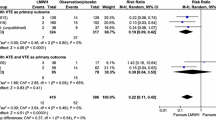Abstract
Venous thromboembolism (VTE) is a frequent complication in cancer patients, and represents an important cause of morbidity and mortality. Especially in those patients who have a poor life expectancy, preventing death from pulmonary embolism is the mainstay of treatment. Critically ill patients should promptly be administered thrombolytic drugs. Except for selected patients requiring aggressive therapy, the initial VTE treatment should be conducted with adjusted-dose unfractionated heparin, fixed-dose low-molecular-weight heparin (LMWH) or fondaparinux. LMWHs and fondaparinux have the potential to greatly simplify the initial treatment of VTE, making the treatment of suitable patients feasible in an outpatient setting. During anticoagulant therapy, cancer patients have a twofold to fourfold higher risk of recurrent VTE and major bleeding complications when compared to non-cancer patients. The long-term administration of LMWH should be considered as an alternative to anti-vitamin K drugs in patients with advanced disease and in those with conditions limiting the use of oral anticoagulants. Prolongation of anticoagulation should be considered for as long as the malignant disorder is active.
Similar content being viewed by others
References
Prandoni P, Falanga A, Piccioli A (2005) Cancer and venous thromboembolism. Lancet Oncol 6:401–410
Levitan N, Dowlati A, Remick SC et al (1999) Rates of initial and recurrent thromboembolic disease among patients with malignancy versus those without malignancy. Risk analysis using Medicare claims data. Medicine (Baltimore) 78:285–291
Stein PD, Beemath A, Meyers FA, Skaf E, Sanchez J, Olson RE (2006) Incidence of venous thromboembolism in patients hospitalized with cancer. Am J Med 119:60–68
Cronin CG, Lohan DG, Keane M, Roche C, Murphy JM (2007) Prevalence and significance of asymptomatic venous thromboembolic disease found on oncologic staging CT. AJR 189:162–170
Blom JW, Doggen CJ, Osanto S, Rosendaal FR (2005) Malignancies, prothrombotic mutations, and the risk of venous thrombosis. JAMA 293:715–722
Chew HK, Wun T, Harvey D, Zhou H, White RH (2006) Incidence of venous thromboembolism and its effect on survival among patients with common cancers. Arch Intern Med 166:458–464
Chew HK, Wun T, Harvey DJ, Zhou H, White RH (2007) Incidence of venous thromboembolism and the impact on survival in breast cancer patients. J Clin Oncol 25:70–76
Lee AY (2005) Management of thrombosis in cancer: primary prevention and secondary prophylaxis. Br J Haematol 128:291–302
Elting LS, Escalante CP, Cooksley C et al (2004) Outcomes and cost of deep venous thrombosis among patients with cancer. Arch Intern Med 164:1653–1661
Kearon C, Kahn SR, Agnelli G, Goldhaber S, Raskob GE, Comerota AJ (2008) Antithrombotic therapy for venous thromboembolic disease: American College of Chest Physicians Evidence-Based Clinical Practice Guidelines (8th Edition). Chest 133(6 Suppl):454–545
Ageno W, Grimwood R, Limbiati S, Dentali F, Steidl L, Wells PS (2005) Home-treatment of deep vein thrombosis in patients with cancer. Haematologica 90:220–224
Siragusa S, Arcara C, Malato A et al (2005) Home therapy for deep vein thrombosis and pulmonary embolism in cancer patients. Ann Oncol 16(suppl. 4):136–139
Gould MK, Dembitzer AD, Doyle RL, Hastie TJ, Garber AM (1999) Low-molecular-weight heparins compared with unfractionated heparin for treatment of acute deep venous thrombosis. A meta-analysis of randomized, controlled trials. Ann Intern Med 130:800–809
Dolovich LR, Ginsberg JS, Douketis JD, Holbrook AM, Cheah G (2000) A meta-analysis comparing low-molecular-weight heparins with unfractionated heparin in the treatment of venous thromboembolism. Arch Intern Med 160:181–188
Investigators The Matisse (2003) Subcutaneous fondaparinux versus intravenous unfractionated heparin in the initial treatment of pulmonary embolism. N Engl J Med 349:1695–1702
Buller HR, Davidson BL, Decousus H et al (2004) Fondaparinux or enoxaparin for the initial treatment of symptomatic deep venous thrombosis. Ann Intern Med 140:867–873
van Doormaal FF, Raskob GE, Davidson BL et al (2009) Treatment of venous thromboembolism in patients with cancer: Subgroup analysis of the Matisse clinical trials. Thromb Haemost 101:762–769
van Doormaal FF, Cohen AT, Davidson BL et al (2010) Idraparinux versus standard therapy in the treatment of deep venous thrombosis in cancer patients: a subgroup analysis of the Van Gogh DVT trial. Thromb Haemost (in press)
Schulman S, Kearon C, Kakkar AK et al (2009) Dabigatran versus warfarin in the treatment of acute venous thromboembolism. N Engl J Med 361:2342–2352
Prandoni P, Lensing AWA, Piccioli A et al (2002) Recurrent venous thromboembolism and bleeding complications during anticoagulant treatment in patients with cancer and venous thrombosis. Blood 100:3484–3488
Lee AY, Levine MN, Baker RI et al (2003) Low-molecular-weight heparin versus a coumarin for the prevention of recurrent venous thromboembolism in patients with cancer. N Engl J Med 349:146–153
Meyer G, Marjanovic Z, Valcke J et al (2002) Comparison of low-molecular-weight heparin and warfarin for the secondary prevention of venous thromboembolism in patients with cancer. Arch Intern Med 162:1729–1735
Conflict of interest
None.
Author information
Authors and Affiliations
Corresponding author
Rights and permissions
About this article
Cite this article
Prandoni, P. The treatment of venous thromboembolism in patients with cancer. Intern Emerg Med 5 (Suppl 1), 27–30 (2010). https://doi.org/10.1007/s11739-010-0445-y
Published:
Issue Date:
DOI: https://doi.org/10.1007/s11739-010-0445-y




